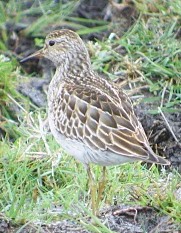Well not exactly quick but I didn't hang around too much, nor did I get too far either, the wind chill was something else again today. No pictures associated with today's efforts - nothing new there then - but....
Striolated Puffbird. Colin Bushell.
One of CB's Puffbirds from his recent birding trip to Peru. Thanks for this Colin, a new bird to me, and to Birds2blog....luvit!
I did the circuit again at Conder Green knowing well the pool would be frozen over when I got round to it, though there was a couple of small 'free' areas with just two Mute Swans holding on to one of them. In the Conder Channel below the railway bridge 2 Spotted Redsank, a Greenshank, Common Sandpiper, 2 Little Grebe, 2 Snipe, and c.320 Wigeon, a Song Thrush and c.30 Chaffinch noted along the coastal path, a Kingfisher flew out of the small pool as I approached it on the west side of the A588 opposite the Galgate Road junction, I wish I had a pound for every time I've seen a Kingfisher flying of this pool.
At Glasson Dock on the Lune Estuary I noted just 7 Goldeneye at a location void of anything at all of note, quite amazing how you can visit an area holding thousands of birds one day and virtually deserted the next. On Jeremy Lane 3 Bewick's Swans with 15 Mute Swans, the Little Owl was on the roof despite the bitter wind which must have been blowing into it's face. The big surprise on this lane for November was at least 6,000 Pink-footed Geese which despite scanning through twice I found no 'hangers on' with them. I'd have been much less surprised to find these birds here in January, more likely in February or even March, but November and particularly in this number....very unexpected.
Well I suppose you'd have to call that a....'Quick Dash' wouldn't you!
And finally....
This is such poor taste it hurts, and I think I may well loose some 'customers' through it's weak humour, but I just cannot resist this photograph I took today of....wait for it....Carr Bank.




































